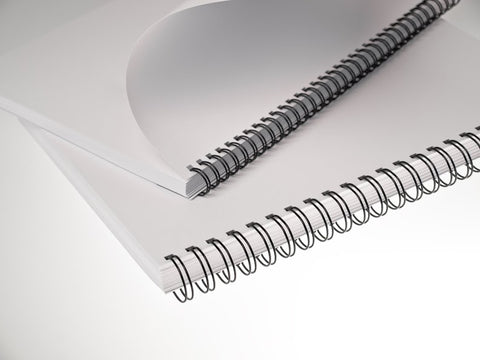About the author: Phil Taylor has over 35 years of experience in the field of manufacturing, sourcing and distributing binders, binding machines, binding supplies and print finishing equipment.

Introduction:
Wire binding is a versatile and efficient method for creating professional-looking documents. Whether you're binding presentations, reports, manuals, or calendars, wire binding offers durability and a polished finish. In this comprehensive guide, we'll delve into the world of wire binding, covering everything from the method itself to different formats and practical tips for success.
What is the Wire Binding Method?
Not to be confused with spiral binding, wire binding, also known as twin loop binding or double loop binding, involves threading a metal wire through a series of closely spaced holes along the edge of a stack of paper. The wire is then closed into a loop using a specialised binding machine, creating a secure and elegant binding. This method allows for 360-degree rotation of bound pages, making it ideal for documents that need to lay flat or fold back on themselves.

What Size Wire Binding Do I Need?
Choosing the right size wire binding is crucial for achieving a professional finish and ensuring the durability of your bound documents. Wire binding comes in various diameters, typically ranging from 6mm (¼ inch) to 38mm (1½ inches). The size you need depends on the thickness of your document. As a general rule of thumb, select a wire diameter that is slightly larger than the thickness of your document, allowing for easy page turning without strain on the binding.
How Many Pages Can You Wire Bind?
One of the key advantages of wire binding is its ability to accommodate a wide range of page counts. Smaller diameter wires are suitable for binding fewer pages, while larger diameters can handle thicker documents. For example, a 6mm (¼ inch) inch wire can typically bind up to 45 sheets of standard 80gsm paper, while a 38mm (1½ inches) wire can accommodate up to 340 sheets. Keep in mind that the actual capacity may vary depending on the paper weight and thickness.
Different Wire Binding Formats:
3:1 Pitch Wire Binding: This format features three holes per inch along the binding edge, making it suitable for binding smaller-sized documents such as calendars, notebooks, or reports. The tighter hole spacing provides a more secure bind, especially for thinner documents. This format is also known as 34-loop because it results in 34 holes in total along the long side of an A4 sheet of paper – hence 34 loop). 3:1 wires are available up to 16mm diameter (around 140 sheets of 80gsm paper), although most machines can only take 3:1 wires up to 14.3mm (around 120 sheets of printer paper). Generally, only Renz brand machines can take 3:1 wires up to 16mm. 3:1 is the most common wire format available in the market.
2:1 Pitch Wire Binding: With two holes per inch, the 2:1 pitch wire binding format is commonly used for larger documents, such as presentations, manuals, or proposals. This format offers a more spacious and open look, ideal for showcasing content across double-page spreads. This format results in 23 holes in total along the long side of an A4 sheet of paper – hence 23 loop). 2:1 wires are available up to 38mm diameter (around 340 sheets of 80gsm paper), although most machines can only take 2:1 wires up to 28.5mm (around 250 sheets of printer paper). Generally, only Renz brand machines can take 2:1 wires up to 38mm. 2:1 is less common than 3:1 but still readily available.
There is an additional variation on 2:1 wire which still consists of 2 holes per inch but only totals 21 holes in total along the long side of an A4 sheet. This is made especially for GBC multi-function comb and wire binding machines only.
Hints and Tips for Wire Binding:
Prep Your Document: Before binding, ensure that your document pages are aligned and properly organised. Smooth out any creases or wrinkles to achieve a professional finish.
Use a Cover: Consider adding a front and back cover to your bound document for added protection and a polished look. Clear plastic covers or cardstock covers are popular options.
Test Your Machine: Familiarise yourself with your wire binding machine before starting your project. Practice with scrap paper to ensure proper alignment and closure of the wire loops.
Invest in Quality Supplies: Choose high-quality wire binding supplies, including wires and covers, to ensure durability and longevity of your bound documents.
Below is a useful video from Fellowes demonstrating the wire binding process. The procedure is not identical for all makes and models, but the principle is the same with a similar process across all machines.
Product Recommendations:
Fellowes Galaxy Heavy Duty Manual Wire Binding Machine: This manual wire binding machine offers durability and efficiency, making it perfect for high-volume binding tasks. It can be used to bind A4 and A5 documents.
GBC WireBind W25e Heavy Duty Electric Wire Binding Machine: For added convenience and speed, consider the GBC W25e electric wire binding machine. This units includes a foot pedal for optional hands free punching. Its heavy-duty design is suitable for demanding binding applications.
Renz eco S 360 Heavy Duty Manual Wire Binding Machine: The Renz eco S 360 manual wire binding machine features a binding capacity of up to 340 Sheets and a punching capacity of up to 30 Sheets. It's a very high quality, German made, heavy duty wire binding machine with a robust, all-metal construction and able to bind A4 &and A5 documents.
Conclusion:
Wire binding is a versatile and efficient method for creating professional-looking documents of all types and sizes. By understanding the wire binding method, selecting the right wire size, exploring different binding formats, and following practical tips, you can master the art of wire binding and elevate the presentation of your documents.


